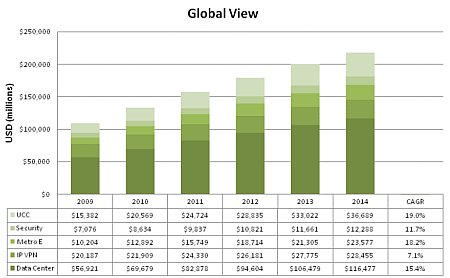Cloud Equipment Market Will Grow From $110Bn in 2009 to $217Bn in 2014.
2009, according to a Cisco sponsored report by Forrester Research Inc, saw a significant uplift of sales of equipment into the cloud services sector despite the global recession. Figures show significantly greater growth in equipment sales that support next generation managed services as opposed to traditional Customer Premises Equipment.

Their forecast for this market is that sales will grow from $110Bn in 2009 to $217Bn in 2014, a CAGR of 15%. It is all very exciting, I guess, unless that is you are stuck selling on premises equipment in which case you probably need to start thinking of career alternatives.
This information came from the Cisco Managed services seminar at the Tower of London last week. What struck me was the huge number of elements that make up the big cloud services picture. I counted 62 different technology areas that Cisco claim make up the whole market. These include areas such as Computing as a Service, Platform as a Service, Infrastructure as a Service and Software as a Service. The range is mind boggling.
This isn’t something that an ISP can undertake on a broad scale, at least not during the initial development stages of this market. You have to cherry pick your offerings.
Forrester have segmented the market into Unified Comms, Metro Ethernet, Security, Managed VPN (MPLS I assume) and Data Center . This may help. Timico plays in all these market segments to greater or lesser degrees which is somewhat reassuring.
 In my mind you have to ignore the buzzwords and get on with satisfying what your customers need. In many cases customers will already have a good idea but there will be many more looking for guidance.
In my mind you have to ignore the buzzwords and get on with satisfying what your customers need. In many cases customers will already have a good idea but there will be many more looking for guidance.
The case for Virtualization, which is a big part of the infrastructure play when it comes to talking about managed services and the cloud, is very strong.
I looked at one specific example of a company that had 217 machines/servers occupying 9 racks. On average each server has 500GB of storage (an assumption on my part but a reasonable one) but a memory utilisation of only 30 – 40%. That’s a usage of only 43TB out of a total available of 108TB (plenty of rounding here).
If this server estate could be distilled onto a robust Storage Area Network that represents a huge potential cost saving, just taking disk space into consideration. More memory is saved because these systems typically recognise which operating systems are being used by the Virtual Machines and do not replicate multiple instances of such software.
What’s more aggregated processing power = better individual VM performance. In other words the processor capacity available to any single machine is far greater than it previously had access to on a single server. This inevitably results in performance efficiencies. The bandwidth story is the same. An individual stand alone server is likely to be served by a maximum of 1Gbps whereas a VM will probably get 10Gbps.
The example I looked at will result in 217 VMs on single 8U blade centre with a capacity 32 servers though we won’t need all 32 for this specific customer.
As Cisco has suggested the market is undergoing a big change right now. One that requires significant investment in infrastructure. I suspect that many familiar names will fail to make it through. It will be interesting to see who emerges into the clear skies beyond the cloud 🙂
Charts are courtesy of Cisco with Data from Forrester Research Inc.


9 replies on “In 2014 the Market for Cloud Equipment Will Double its 2009 Tally”
great potential here for a community network with its own data centre hosting its own cloud. All the educational, healthcare and business needs of a county could be kept local. Could save the area a packet.
no pun intended.
wonder when bduk will catch up?
probably in 10 years when they realise cabinets were a big mistake.
again no pun intended.
doh. digitalbritianmyarse, the future is here, its just that we are ignoring IT.
chris
Definitely. Biggest question would be whether the community had the scale to merit its own private cloud.
Clouds are a hot topic this side of the world from a disaster recovery / business continuity perspective. http://www.zdnet.com.au/cloud-gets-post-quake-boost-339311182.htm
tref/cyberdoyle – where do the savings come from with a community network data centre? If they were installed, wait a few years and they would be combined to save on accommodation, support etc. This is about economies of scale. Because bandwidth is getting cheaper…
And what has this got to do with cabinets?
Tref – Communities, whatever they are, cannot manage a data network, it’s a job for the professionals like you. Better to connect to eg. Lincoln than a village hall.
There is no need to keep things within a county, why?
You are quite right Somerset. The cloud is a fairly substantial investment. I can’t really see it living in a village hall. I can see it living in the nearest large town though because whilst we are talking virtual products here the reality is that a business needs support for these products. If someone has to quickly rebuild a virtual server or recover lost data then this isn’t something you want to delegate to an online helpdesk or someone on a different continent.
If push comes to a shove you want to be able to meet up with your support organisation to discuss options.
Tref – what applications would run on local servers and what is the real benefit?
Why does Cyberdoyle think there is a saving?
I’m not sure cyberdoyle understands cloud computing. Cumbria could have a data centre now if it wanted to now in a central place, but why would it…
What is cloud computing ?
It is a revamped version of the old service bureau model with todays communications. The hardware could be internal (centralized storage and processing), external (commercial provider or govt. super-center), or a mixture.
Why do it ?
In a word – CONTROL. A good sized town or county with an internal cloud can save on workstation costs (O/S licenses !), centralize backups, and improve security from fire and theft. Also, upgrades become more manageable due to having the complicated parts in one or two places rather than scattered between several offices and / or buildings.
Are technical skills a barrier ?
No. While a town or county may not have the requisite skills on staff there are two likely sources of talent – consultants and schools. I personally would prefer to reach out to a local trade school or university and set up a partnership that involves some sort of internship. The govt. body gets cost effective assistance while the school has a real world example to draw on.
But does not have to be related to a town or county. An individual person or business can use a service based anywhere. Who in a town would would fund the setup and how would they attract customers?